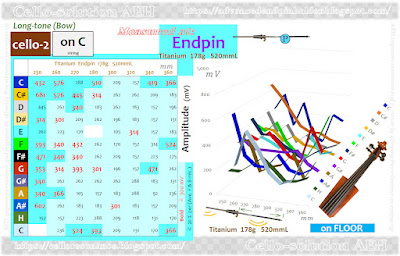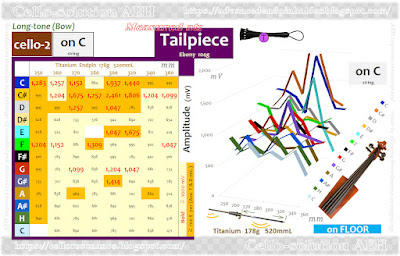[ 12/30/2021 ] Labels: 53.Endpin-Resonance3
Endpin resonance was checked over a wide area deploying a carbon endpin(73g,455mmL) and/or a titanium endpin(178g,520mmL) on CELLO-2, from C(66Hz) to A(884Hz).
The resonant area, like a series of mountains, was seen linearly throughout almost everywhere. However the inclination direction was strange. Long endpin at lower tones and short endpin at higher tones shared the same continuous resonance. In other words, endpin's extra(/excess) length actually seems taking an initiative of the resonance, inside the dark cello body.
Take a try a simple test using a thin acrylic rod, for example. When the one end of the rod fixed and other one optional point is pinched (with your fingers) and shaken, the rod will resonate taking a convenient cycle according to the extra(/excess) length. Long extra length rod brings a slow(low frequency) vibration. Seems like a same behavior as endpins.
--エンドピンの余長がエンドピンの共振を決めている--
チェロ-2と カーボンエンドピン(73g,455mmL)とチタンエンドピン(178g,520mmL)の組み合わせで、最低音C(66Hz)-A線上の高音A(884Hz)に渡ってエンドピンの長さを調整しながらエンドピンの共振パターンを調べた。エンドピンの材質によって傾きに違いはあるが、エンドピンの長さと与えられるトーン(周波数)で直線的に連続した山脈と谷状の共鳴域が(交互に)現れることが分かった。長いエンドピンの時低音側で起こるものと短いエンドピンで高音側で起こるものが同じ(共振振動数)であった。つまりチェロの筐体の外に引き出されている長さではなく、筐体内に隠れている余長の長さこそがエンドピンの大きな共振を決めていたのだ。
ちなみに5mm角程度のアクリル棒の一端を固定し、適当な位置をつまんで揺すって(振動させて)みると解る。余長が短いと短周期で、長いと長周期で共振する。まさに同じことがエンドピンで起こっていて、大部分のチェロの音域で主たるエンドピンの共振を決めていると考えられる。


















































